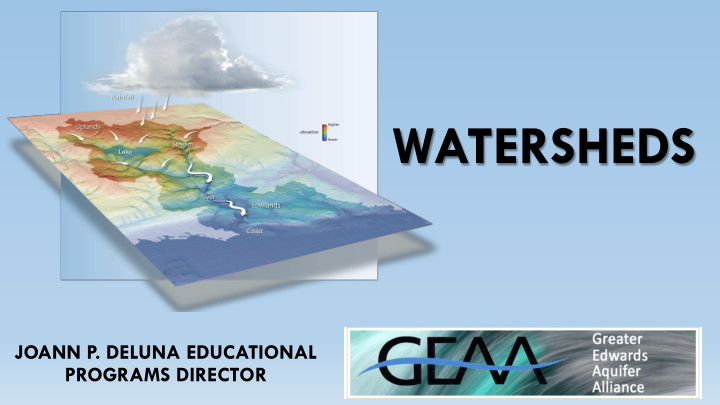



WATERSHEDS JOANN P. DELUNA EDUCATIONAL PROGRAMS DIRECTOR
OBJECTIVES: • BE ABLE TO DEFINE WHAT A WATERSHED IS. • BE ABLE TO LIST 5 WAYS THAT HUMANS IMPACT WATERSHEDS. • BE ABLE TO LIST 5 ACTIONS THAT YOU CAN TAKE TO HELP PROTECT WATER QUALITY IN OUR WATERSHED. • BE ABLE TO EXPLAIN WHY WETLANDS AND ESTUARIES ARE IMPORTANT.
Drought has become a major threat the our water supply
A WATERSHED is the area of land where all of the water that falls in it and drains off of it goes into the same place. Think of a watershed as a precipitate collector.
The watershed consists of surface water--lakes, streams, reservoirs, and wetlands--and all the underlying ground water.
Watersheds can also be called Elevated areas like ridges or hills that separate two watersheds are drainage basins or catchment called a drainage divide areas or contributing zone.
• A catchment is an area where water is collected by the natural landscape. In a catchment, all rain and run-off water eventually flows to a creek, river, lake or ocean, or into the groundwater system. Natural and human systems such as rivers, farms, dams, homes, plants, animals and people can co-exist in a catchment. • Healthy catchments provide: • • a source of clean drinking water • • unspoiled natural areas for recreation • • habitat for plants and animals • • healthy vegetation and waterways • • reliable and clean water for stock and irrigation • • opportunities for sustainable agriculture and industry.
Texas watersheds
Bexar County has several watersheds
Government Canyon State Natural Area is part of the upper Leon Creek watershed and located over our recharge zone.
This watershed was purchased by the city of San Antonio to protect the quality of the recharge water entering our aquifer.
Runoff is when water drains from elevated areas to lower ones.
The amount of impervious (impermeable) surface in an area is a major factor in determining the amount of runoff.
When creeks cross fractures in the limestone over the recharge zone water will enter our aquifer.
Seco Creek Recharge Project Water is collected and channeled into the sinkhole to increase aquifer recharge . Sinkholes can quickly receive large volumes of recharge during rainstorms and transmit the recharge directly into the aquifer.
The San Antonio River watershed drains into the Gulf of Mexico.
We need to realize that our actions affect everyone that is downstream in our watershed.
There are 2 kinds of pollution that affect our surface and groundwater. Point Source Pollution comes from an identifiable source.
Both Point and Nonpoint Source Pollution have a major effect on the quality of the water that goes downstream in our watershed.
Non Point Source Pollution can come from a variety of sources – especially these soluble (will dissolve in water)substances. People should Not use these substances on their lawns!
Urban runoff carries pollution into streams.
The most common source of non-point pollution is contaminated storm water. Think before you wash pollutants into the storm water drain.
Animal feces is a major problem in water contamination
Pet feces can get into surface and groundwater if not picked up and disposed of in the garbage.
Map of Sewage Spills in Central Texas
What we dump goes downstream into our watershed.
Construction sites are a major source of soil erosion.
This soil is washed into streams, were it can enter the aquifer or is carried to the coast.
Medicines are now a major source of water pollution.
Every city downstream uses our wastewater for their drinking water.
We need to think about how our watershed affects estuaries and wetlands at the coast.
Wetlands help to naturally filter out pollutants from the water.
Coastal organisms live and reproduce in estuaries. It is very important that estuaries receive a constant source of clean unpolluted water to maintain the balance of fresh and salt water.
Whooping cranes are one of the endangered species that live at the coast and depend on a constant source of clean water.
If the estuaries do not receive a steady supply of fresh clean water then the salinity and pollution increases causing organisms who are producers and lower level consumers to die off. This can crash the food chain.
Fertilizers are water soluble and are transported by stream flow to the coast where they can create a toxic algae growth called a Red Tide.
So what can you do to help out ? you can make a difference! • Conserve water – use it wisely! • Do not ever pour medicine or toxic substances down the drain. • Do not use the toilet as a trashcan. • Do not use pesticides, herbicides, or fertilizer on your lawn. • Pick up after your pets. • Don’t litter! Pick up your trash. • Share this information with adults. • Plan and construct a Rain Garden on your school grounds.
Constructing and maintaining Rain Gardens are one way that we can help to clean the water entering our watershed.
• This presentation was made possible by generous support from Rackspace and the Greater Edwards Aquifer Alliance a nonprofit organization dedicated to protecting the major source of our drinking water… the Edwards Aquifer
Estuaries are where fresh water meets salt water .
The water that our city discharges into the San Antonio River has a direct impact on the quality of the water downstream and at the coast.
We need to do our part to protect the quality of water going into our watershed if we want to continue to have enough clean water for all of our needs.
Recommend
More recommend